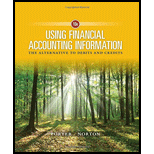
Using Financial Accounting Information
10th Edition
ISBN: 9781337276337
Author: Porter, Gary A.
Publisher: Cengage Learning,
expand_more
expand_more
format_list_bulleted
Concept explainers
Question
Chapter 3, Problem 3.12.1AAMCP
To determine
Concept Introduction:T- Shape account means a detailed statement which contains the complete details of transactions of a particular account. T-Shape gives balance of particular account at the end of year. Ending balances are helpful in preparing the
To Prepare: T Shape account for every transaction mentioned.
Expert Solution & Answer
Want to see the full answer?
Check out a sample textbook solution
Students have asked these similar questions
no ai
An asset's useful life is the same as its physical life?
True
False
no ai
Depreciation Expense reflects an allocation of an asset's original cost rather than an allocation based on the economic value that is being consumed.
True
False
The purpose of depreciation is to have the balance sheet report the current value of an asset.
True
False
Chapter 3 Solutions
Using Financial Accounting Information
Ch. 3 - Prob. 3.1ECh. 3 - Prob. 3.2ECh. 3 - Prob. 3.3ECh. 3 - Prob. 3.4ECh. 3 - Prob. 3.5ECh. 3 - Prob. 3.6ECh. 3 - Prob. 3.7ECh. 3 - Prob. 3.8ECh. 3 - Prob. 3.9ECh. 3 - Prob. 3.10E
Ch. 3 - Prob. 3.11MCECh. 3 - Prob. 3.12MCECh. 3 - Prob. 3.13MCECh. 3 - Prob. 3.14MCECh. 3 - Prob. 3.15MCECh. 3 - Prob. 3.16MCECh. 3 - Prob. 3.17MCECh. 3 - Prob. 3.18MCECh. 3 - Prob. 3.1PCh. 3 - Prob. 3.2.1PCh. 3 - Prob. 3.2.2PCh. 3 - Prob. 3.2.3PCh. 3 - Prob. 3.2.4PCh. 3 - Transaction Analysis and Financial Statements...Ch. 3 - Prob. 3.3.2PCh. 3 - Prob. 3.3.3PCh. 3 - Prob. 3.3.4PCh. 3 - Prob. 3.4PCh. 3 - Prob. 3.5.1MCPCh. 3 - Prob. 3.5.2MCPCh. 3 - Prob. 3.5.3MCPCh. 3 - Prob. 3.6.1MCPCh. 3 - Transaction Analysis and Financial Statements Blue...Ch. 3 - Prob. 3.6.3MCPCh. 3 - Prob. 3.6.4MCPCh. 3 - Prob. 3.7.1MCPCh. 3 - Prob. 3.7.2MCPCh. 3 - Transaction Analysis and Financial Statements...Ch. 3 - Prob. 3.8MCPCh. 3 - Prob. 3.9.1MCPCh. 3 - Problem 3-9 Transaction Analysis and Journal...Ch. 3 - Prob. 3.10.1MCPCh. 3 - Prob. 3.10.2MCPCh. 3 - Prob. 3.10.3MCPCh. 3 - Prob. 3.10.4MCPCh. 3 - Prob. 3.11MCPCh. 3 - Prob. 3.12.1MCPCh. 3 - Prob. 3.12.2MCPCh. 3 - Prob. 3.13.1MCPCh. 3 - Prob. 3.13.2MCPCh. 3 - Prob. 3.14.1MCPCh. 3 - Prob. 3.14.2MCPCh. 3 - Prob. 3.14.3MCPCh. 3 - Prob. 3.14.4MCPCh. 3 - Prob. 3.14.5MCPCh. 3 - Prob. 3.15.1MCPCh. 3 - Prob. 3.15.2MCPCh. 3 - Prob. 3.15.3MCPCh. 3 - Prob. 3.15.4MCPCh. 3 - Prob. 3.1AAPCh. 3 - Prob. 3.2.1AAPCh. 3 - Transaction Analysis and Financial Statements...Ch. 3 - Transaction Analysis and Financial Statements...Ch. 3 - Prob. 3.3.1AAPCh. 3 - Transaction Analysis and Financial Statements...Ch. 3 - Transaction Analysis and Financial Statements...Ch. 3 - Prob. 3.3.4AAPCh. 3 - Prob. 3.4AAPCh. 3 - Prob. 3.5.1AAMCPCh. 3 - Prob. 3.5.2AAMCPCh. 3 - Prob. 3.5.3AAMCPCh. 3 - Prob. 3.6.1AAMCPCh. 3 - Prob. 3.6.2AAMCPCh. 3 - Prob. 3.7.1AAMCPCh. 3 - Prob. 3.7.2AAMCPCh. 3 - Prob. 3.8AAMCPCh. 3 - Prob. 3.9.1AAMCPCh. 3 - Prob. 3.9.2AAMCPCh. 3 - Prob. 3.10.1AAMCPCh. 3 - Prob. 3.10.2AAMCPCh. 3 - Prob. 3.10.3AAMCPCh. 3 - Prob. 3.10.4AAMCPCh. 3 - Prob. 3.11AAMCPCh. 3 - Prob. 3.12.1AAMCPCh. 3 - Prob. 3.12.2AAMCPCh. 3 - Prob. 3.13.1AAMCPCh. 3 - Prob. 3.13.2AAMCPCh. 3 - Prob. 3.14.1AAMCPCh. 3 - Prob. 3.14.2AAMCPCh. 3 - Prob. 3.15.1AAMCPCh. 3 - Prob. 3.15.2AAMCP
Knowledge Booster
Learn more about
Need a deep-dive on the concept behind this application? Look no further. Learn more about this topic, accounting and related others by exploring similar questions and additional content below.Similar questions
- Hello tutor please help me this questionarrow_forwardPlease provide the correct answer to this general accounting problem using accurate calculations.arrow_forwardHarmony Books is a direct marketer of educational books. The following information about its revenue and cost structure is available: ⚫ Selling Price: $25.00 per book Variable Costs: 。 Production: $8.00 per book 。 Selling and Administration: $3.50 per book ⚫ Fixed Costs: $94,500 What is the break-even point in books for Harmony Books?arrow_forward
arrow_back_ios
SEE MORE QUESTIONS
arrow_forward_ios
Recommended textbooks for you
- Principles of Accounting Volume 1AccountingISBN:9781947172685Author:OpenStaxPublisher:OpenStax College
 Financial AccountingAccountingISBN:9781337272124Author:Carl Warren, James M. Reeve, Jonathan DuchacPublisher:Cengage Learning
Financial AccountingAccountingISBN:9781337272124Author:Carl Warren, James M. Reeve, Jonathan DuchacPublisher:Cengage Learning Financial AccountingAccountingISBN:9781305088436Author:Carl Warren, Jim Reeve, Jonathan DuchacPublisher:Cengage Learning
Financial AccountingAccountingISBN:9781305088436Author:Carl Warren, Jim Reeve, Jonathan DuchacPublisher:Cengage Learning  Cornerstones of Financial AccountingAccountingISBN:9781337690881Author:Jay Rich, Jeff JonesPublisher:Cengage Learning
Cornerstones of Financial AccountingAccountingISBN:9781337690881Author:Jay Rich, Jeff JonesPublisher:Cengage Learning College Accounting (Book Only): A Career ApproachAccountingISBN:9781337280570Author:Scott, Cathy J.Publisher:South-Western College Pub
College Accounting (Book Only): A Career ApproachAccountingISBN:9781337280570Author:Scott, Cathy J.Publisher:South-Western College Pub

Principles of Accounting Volume 1
Accounting
ISBN:9781947172685
Author:OpenStax
Publisher:OpenStax College

Financial Accounting
Accounting
ISBN:9781337272124
Author:Carl Warren, James M. Reeve, Jonathan Duchac
Publisher:Cengage Learning

Financial Accounting
Accounting
ISBN:9781305088436
Author:Carl Warren, Jim Reeve, Jonathan Duchac
Publisher:Cengage Learning

Cornerstones of Financial Accounting
Accounting
ISBN:9781337690881
Author:Jay Rich, Jeff Jones
Publisher:Cengage Learning


College Accounting (Book Only): A Career Approach
Accounting
ISBN:9781337280570
Author:Scott, Cathy J.
Publisher:South-Western College Pub
The accounting cycle; Author: Alanis Business academy;https://www.youtube.com/watch?v=XTspj8CtzPk;License: Standard YouTube License, CC-BY